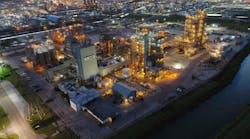ACCURACY: The combined error of nonlinearity, repeatability, and hysteresis expressed as a percent of full-scale output.
BERNOULLI: In fluid dynamics, Bernoulli’s principle states that for an inviscid flow, an increase in the speed of the fluid occurs simultaneously with a decrease in pressure or a decrease in the fluid’s potential energy. Bernoulli’s principle is named after the Dutch-Swiss mathematician Daniel Bernoulli, who published his principle in his book Hydrodynamica in 1738.
CORIOLIS: The mathematical expression for the Coriolis force appeared in an 1835 paper by French scientist Gaspard-Gustave Coriolis in connection with the theory of water wheels, and also in the tidal equations of Pierre-Simon Laplace in 1778. Early in the 20th century, the term Coriolis force began to be used in connection with meteorology.
DELTA P: Delta P devices, such as orifice plates, Venturis, and sonic nozzles, can be used to measure the volumetric flowrate of most liquids and gases. Delta P devices have an inherent relationship between the pressure drop across the device and the volumetric flowrate that the device is measuring. A pressure transducer or manometer records the difference between these two pressures.
DRIFT: A change of reading or setpoint value over long periods due to several factors, including change in ambient temperature, time, and voltage.
FULL SCALE: The maximum measurand that a transducer is designed to measure within its specification. Full scale flow is also known as Rated Capacity.
LINEARITY: A constant relation between the change in the output and input in a metering system.
MASS FLOW: Mass flow describes the mass of a medium that moves through a cross section (such as a pipe or a duct) in a certain time interval.
PRESSURE LOSS: The drop in pressure as measured at the inlet of a device minus the pressure as measured at the outlet of that same device.
RANGEABILITY: The ratio of the maximum flowrate to the minimum flowrate of a meter.
REPEATABILITY: The closeness of agreement among repeated measurements of the same variable under the same conditions.
REYNOLDS NUMBER: In fluid mechanics, the Reynolds number is the ratio of inertial forces (vsr) to viscous forces (μ/L), and consequently it quantifies the relative importance of these two types of forces for given flow conditions. Thus, it is used to identify different flow regimes, such as laminar or turbulent flow.
THIXOTROPIC FLOW: Fluids that show a time-dependent change in viscosity when shear-stress is applied.
VISCOSITY: The viscosity of a fluid is the ability of the fluid to flow over itself. Water has a viscosity of about 1 cP.
VOLUMETRIC FLOW: The volumetric flowrate in fluid dynamics is the volume of fluid that passes through a given surface (such as a pipe or duct) per unit time. It is usually represented by the symbol Q.
The terms and definitions for this glossary were compiled from various sources by Flow Control magazine.

